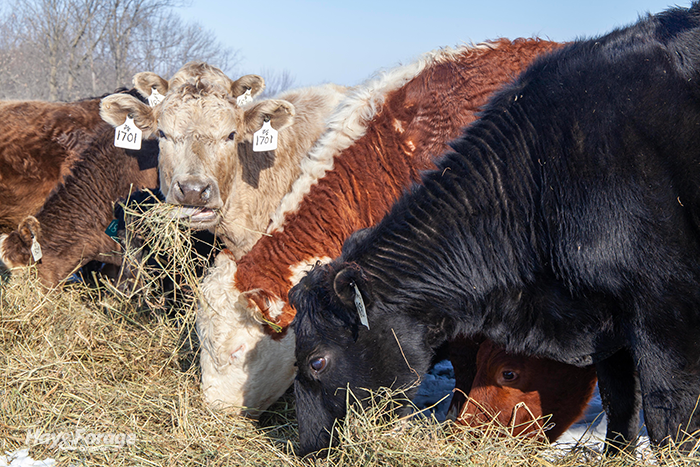
It’s not unusual to feed supplemental hay on pastures during the winter or when forage is short during the growing season. In doing so, nutrients in the hay are imported to the pasture and spread through the deposition of livestock excrement. It’s estimated that between 60% and 99% of the nutrients contained in forage and consumed by cattle are recycled back to the soil as animal urine and/or manure.
There are several strategies to feed hay on winter pastures, but two of the more popular approaches are by using a ring feeder or unrolling bales on the ground. Researchers at the University of Arkansas evaluated the effect that both these methods had on the nutrient and physical properties of soil. They recently reported the results in Crop, Forage & Turfgrass Management.
The study was completed on a private farm in northwest Arkansas during two consecutive winters on a rotationally grazed pasture. The randomized and replicated paddocks were assigned to either a control treatment (no hay fed), unrolled bales, or ring-fed bales. Forty-six Red Angus cow–calf pairs were fed hay at a rate of 6.6 tons per acre per year on a dry-weight basis from December to February during the 2015 to 2016 and 2016 to 2017 winters.
The pastures were located on a silt loam soil that was low in fertility. Soil nutrient levels and physical properties were measured both pre- and post-treatments. The hay used in the study contained an average 11.7, 5.1, and 17.6 pounds per bale of nitrogen (N), phosphorus (P) as P2O5, and potassium (K) as K2O, respectively, on a dry-weight, fertilizer-equivalent basis.
So, what happened?
Extractable soil K increased over the two-year period by 126% and 83% for the unrolled and ring-fed treatments, respectively, but did not change over time where no hay was fed. Extractable soil K was lower in the unamended control at the end of the trial than in the ring-fed and unrolled treatments, which did not differ. Extractable soil magnesium (Mg) increased over time by 19.4%, 33.3%, and 51.2% for the control, ring-fed, and unrolled treatments, respectively.
The researchers noted that it is interesting soil P did not significantly change over the duration of the study because of the imposed treatments. Several possible reasons were given for this, but previous studies have documented a rise in soil P concentration, and this would be expected to occur in most situations after feeding hay on pasture for an extended period.
Prior to the study, it was hypothesized that treatments where hay was fed using the ring feeder would result in less uniform distribution of nutrients; however, this did not happen for extractable soil P and K concentrations.
There were differences in soil bulk density because of imposed treatments, which decreased over time in the unrolled hay treatment but did not change over time in the control and ring-fed treatments. Water infiltration was greater in the unrolled than in the ring-fed treatments.
For additional results and explanation, readers can find the full published study here.

